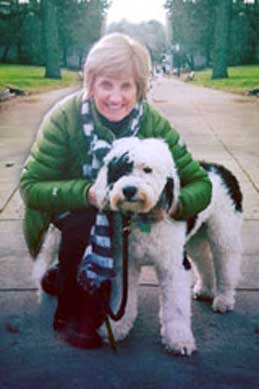Map, the Therapy Dog Provides Kids Comfort and Support

by Ann Densmore, Ed.D., CCC SLP/A
After years of hoping and searching, and a couple more of training, I finally have the perfect partner in my practice as a speech and play therapist: a Portuguese water dog named Map. Like any good therapy dog, Map can reach children in a way that no one else can.
Therapy dogs provide comfort and support. They must be social, gentle, and enjoy getting and giving physical affection−Maps has those qualities in spades. They also must be well behaved and respond to their handlers, neither of which applied to Map when I got him as a puppy. He chewed everything in sight. On walks, he sniffed every blade of grass, picked up every acorn and nosed into every clump of mud, no matter what I said or wanted.
After many therapy dog classes and a lot of practice, we learned. I say “we” because I had to be trained as well. I’ll admit, there were many bumps on the road, but after two years of training, Map became a certified therapy dog. He shines when he is in his blue training coat visiting a preschool. He loves to see the kids and to work with me.
How does Map help kids? His presence somehow lets children open up to learning. He offers kids a way to feel more whole in the face of physical illness or disability. He can also help children heal from emotional pain. One child I worked with, a four year old, lost his parents on 9/11. He stopped talking and refused to answer anyone. Over several visits, Map helped this child find his voice again.
Children with language delays or developmental disabilities are a big part of my practice. For those who are comfortable with dogs, Map is a great co-therapist. Children practice social skills and talk to Map as if he is a peer. I worked with one perky four year old who would not talk or make any sounds. He had what’s called childhood developmental dyspraxia. This is the inability to produce sound combinations with vowels and consonants. Out of frustration he threw tantrums instead of requesting things from his parents and he substituted a gesture system for language. I knew that children in a crisis state can relate to animals, so I brought Map to his school to see him. The child smiled, leaned over Map and buried his face into his coat. He looked up and said, “Puppeeeeee!” This was his first word. It was a long process to recovery, but the child got better−and Map was there to help. By the age of six, this boy could converse just like his peers. His parents happily had a new problem, “Can you get this child to stop talking? We can’t get in a word!” they told me.
Sharing and negation skills are something else that Map can help me help children improve. Sometimes Map sets the example. He is good at sharing his beloved rubber bone. A child can take away his bone and Map won’t budge or move. The child then shares a toy with Map.
Map is also trained to follow a child in play and focus on him or her, giving the child his undivided attention. Even though many children get this kind of attention from their family, they still love this special attention from a trained therapy dog. As you can see in the video below, Map can stay with a child during an obstacle course and, just as important, is a good listener.
Like any great therapist, Map knows how to listen and how to help children help themselves.
About the Author: Ann Densmore, Ed.D., CCC SLP/A is a certified speech & language pathologist and audiologist working with children with PDD/autism over 30 years. She runs a private practice in Lexington, MA, and consultes nationally and internationally. Ann’s work appears on the Harvard Medical School blog and she speaks at multitudes of conferences that include Harvard Med School, Tufts, AANE and more. To learn more about Ann and the value of therapy dogs, please visit www.child-talk.com.




